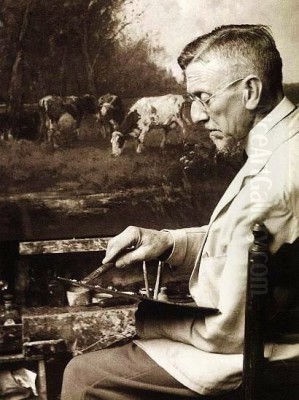
Johan Frederik Cornelis Scherrewitz stands as a significant figure in Dutch art from the late nineteenth and early twentieth centuries. Born in Amsterdam on March 18, 1868, and passing away in Hilversum on August 9, 1951, Scherrewitz dedicated his artistic career to capturing the enduring landscapes and traditional ways of life in the Netherlands. He became particularly renowned for his depictions of coastal fisherfolk, pastoral shepherd scenes, and the quiet beauty of the Dutch countryside, earning recognition both domestically and internationally. His work offers a window into a world undergoing gradual change, rendered with sensitivity and technical skill.
Scherrewitz's journey into the art world was not preordained. His father had envisioned a different path for him, hoping he would pursue a career in medicine. However, the young Scherrewitz felt a stronger calling towards the visual arts. Ultimately, he followed his passion, choosing to become a painter and draughtsman, a decision that would shape the rest of his life and contribute significantly to the tradition of Dutch landscape and genre painting. This early determination set the stage for a career focused on observing and interpreting the world around him through an artistic lens.
Early Life and Artistic Formation
Born into a society that was experiencing the ripples of industrialization yet still deeply connected to its agrarian and maritime roots, Scherrewitz's formative years in Amsterdam likely exposed him to both the bustling city life and the accessible countryside. This duality may have informed his later preference for rural and coastal subjects, perhaps seeking solace or authenticity away from urban centers. His decision to defy familial expectations and pursue art suggests a strong individual will and a deep-seated need for creative expression.
Crucial to Scherrewitz's development as an artist was the guidance he received from established painters. He sought formal training and became a pupil of Johan Diderik Cornelis Veltens (1814-1894), a respected landscape painter. Veltens, known for his detailed and often historically evocative landscapes, likely provided Scherrewitz with a solid foundation in the techniques of landscape representation and the importance of observation. This initial mentorship would have grounded him in the traditions of Dutch painting.
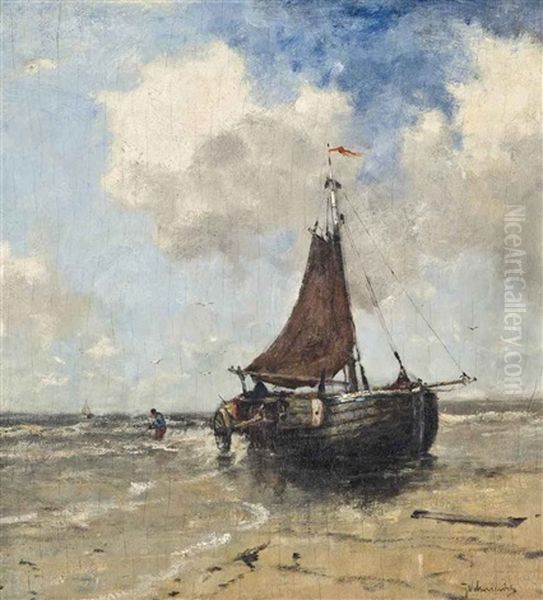
Perhaps even more influential was his tutelage under George Jan Hendrik Poggenbeek (1853-1903). Poggenbeek was a prominent figure associated with the Hague School and later Dutch Impressionism, celebrated for his atmospheric landscapes, often featuring water meadows and cattle. Poggenbeek's looser brushwork and emphasis on mood and light, characteristic of the Hague School's evolution, profoundly impacted Scherrewitz's own developing style. It's likely Poggenbeek encouraged Scherrewitz to capture not just the topography, but the feeling of the Dutch landscape.
The influence of Poggenbeek can be seen in Scherrewitz's handling of light and atmosphere, even though Scherrewitz often maintained a greater degree of detail than some of his more purely Impressionistic contemporaries. This blend of traditional draughtsmanship, likely reinforced by Veltens, and the atmospheric sensitivity championed by Poggenbeek, became a hallmark of Scherrewitz's unique artistic voice. He learned to balance careful observation with evocative rendering.
Artistic Style and Themes
Johan Scherrewitz carved a distinct niche for himself within the Dutch art scene, focusing primarily on landscape and genre subjects. His oeuvre is dominated by scenes drawn from the everyday lives of rural and coastal communities in the Netherlands. He possessed a particular affinity for the landscapes of North Holland, frequently depicting its characteristic forests, heathlands, dunes, and waterways. These settings provided the backdrop for his recurring themes.
Shepherds tending their flocks became one of Scherrewitz's signature subjects. He captured these pastoral scenes with a sense of quiet dignity, often depicting the shepherd guiding his sheep through misty fields, along sandy tracks, or emerging from simple barns. These works evoke a timeless connection between humanity and nature, portraying a way of life that seemed increasingly distant from the modernizing world. His paintings often emphasize the textures of wool, the rough bark of trees, and the soft light of dawn or dusk.
Equally important were his depictions of fisherfolk and coastal life. He painted scenes of fishing boats (often the traditional flat-bottomed bomschuiten) pulled up on the beach, fishermen unloading their catch, mending nets, or navigating coastal waters. These works convey the arduous nature of their labour but also the rugged beauty of the seaside environment. He skillfully rendered the interplay of light on water, the weathered surfaces of boats, and the hardy figures of the fishermen and their families. Katwijk and Scheveningen were likely locations that inspired these coastal scenes.
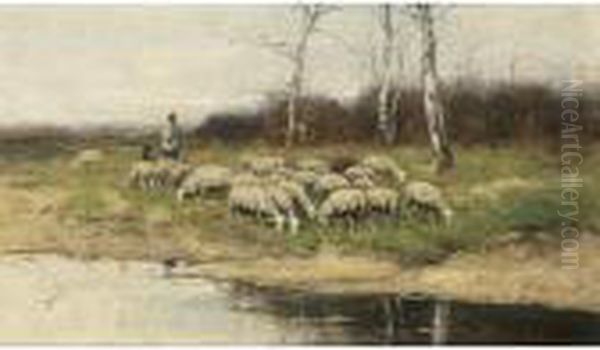
Scherrewitz's style is often associated with the later phase or lingering influence of the Hague School, sometimes termed Dutch Impressionism. While influenced by the Hague School's emphasis on atmosphere, mood, and tonal harmony, Scherrewitz generally retained a clearer structure and more detailed rendering than artists like Jacob Maris or Anton Mauve in their looser moments. His brushwork, while often visible and expressive, served to define form and texture with considerable precision. He excelled at capturing the specific qualities of Dutch light – whether the silvery haze of a coastal morning or the dappled sunlight filtering through a forest canopy.
His palette typically favoured naturalistic, often earthy tones, reflecting the landscapes he depicted. Greys, blues, greens, and browns dominate, punctuated by subtle variations that create depth and atmosphere. He avoided the vibrant, broken colour of French Impressionism, adhering instead to a more tonal approach rooted in Dutch tradition. The overall effect is one of realism imbued with a gentle, often melancholic, romanticism. His work celebrated the enduring character of the Dutch landscape and its traditional inhabitants.
Key Locations and Career Path
Scherrewitz's life and career saw him move between several key locations within the Netherlands, each potentially influencing his work and connections within the art world. He began his artistic journey in his birthplace, Amsterdam, where he lived and worked until approximately 1898. Amsterdam, as the country's cultural and artistic hub, would have provided him access to training, museums, galleries, and fellow artists, including his teachers Veltens and Poggenbeek.
Around 1898, Scherrewitz made a significant move to Laren, a village in the Gooi region southeast of Amsterdam. Laren had become a burgeoning artists' colony, attracting painters drawn to its picturesque rural surroundings and relatively untouched traditional life. It was closely associated with figures from the Hague School, such as Anton Mauve (who was married to a cousin of Vincent van Gogh and briefly mentored him), and later artists like Albert Neuhuys, known for his intimate portrayals of peasant interiors. Living and working in Laren would have immersed Scherrewitz in an environment dedicated to capturing rural themes, reinforcing his chosen subject matter.
His time in Laren was followed by a period in The Hague, where he resided briefly between 1902 and 1904. The Hague, of course, was the namesake of the influential Hague School movement. While the movement's peak had passed by the early 1900s, the city remained an important art center. His stay there might have further solidified his connections with the artistic legacy of painters like Jozef Israëls, Willem Maris, Jacob Maris, and Hendrik Willem Mesdag, even if he interacted more with their successors or the continuing tradition.
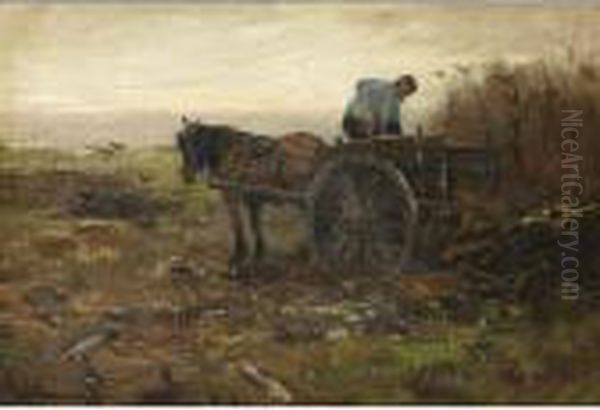
Ultimately, Scherrewitz settled in Hilversum, another town in the Gooi region, not far from Laren. He remained based in Hilversum for the rest of his life. This area, known for its heathlands, woods, and proximity to both rural landscapes and coastal areas, provided ample inspiration consistent with his preferred subjects. His decision to settle here suggests a lasting attachment to the landscapes and atmosphere of this part of the Netherlands.
While Scherrewitz primarily focused on Dutch subjects, sources indicate he did travel, including trips to Germany and France. However, his heart and artistic focus remained firmly rooted in his homeland. The specific character of the Dutch light, landscape, and traditional life formed the core of his artistic identity throughout his career, regardless of his specific place of residence. His movements reflect a path common to many artists of his generation: initial training in a major city, a period engaging with an artists' colony, and eventually settling in a location that offered sustained inspiration.
Representative Works
Several specific works exemplify Johan Scherrewitz's style and thematic concerns. While titles can vary slightly in translation or auction records, his core subjects remain consistent.
One frequently cited subject involves fishermen and their activities on the coast. Paintings titled variations of "Landing the day's catch" or "Dutch Fishing Boats Unloading" capture the essence of this theme. These works typically depict scenes on the beach, often at low tide, where sturdy fishing vessels (bomschuiten) are beached. Fishermen, sometimes aided by horses and carts, are shown hauling in nets or unloading baskets of fish. Scherrewitz excels in these scenes at portraying the wet sand reflecting the sky, the robust forms of the boats, and the figures working against the elements under expansive, often cloudy, Dutch skies. An example, simply titled "Landing the day's catch," showcases his ability to render the scene with both accuracy and atmospheric effect.
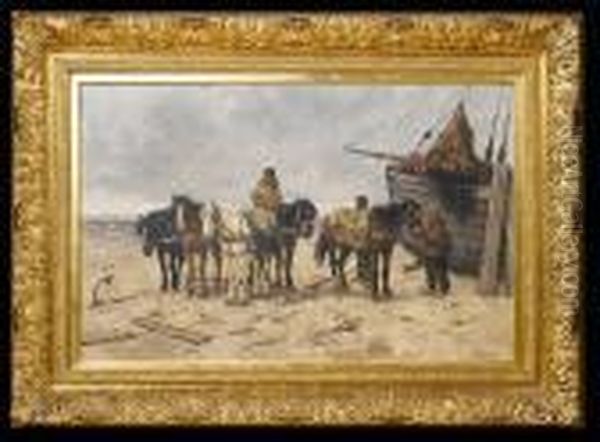
Another signature theme is the shepherd with his flock. Works like "Het weiden van de schapen" (literally "The grazing of the sheep," but often translated as "Shepherd with his Flock" or similar) or "Shepherds and their herd leaving the sheepfold" are central to his oeuvre. These paintings often depict a solitary shepherd, sometimes accompanied by a dog, guiding a dense flock through heathland, along a sandy path, or near a simple wooden barn. The focus is often on the collective movement of the sheep, the texture of their fleece, and the quiet relationship between the shepherd and his animals within a specific landscape setting – perhaps the Gooi heathlands near Laren or Hilversum. The mood is typically tranquil, sometimes tinged with the melancholy of dawn or dusk light.
A painting titled "Bomschuit en schelpenkar op het strand van Katwijk" ("Bomb barge and shell cart on the beach at Katwijk") combines his interest in coastal life with specific details of local work. The bomschuit is the characteristic fishing boat, while the schelpenkar was a cart used for collecting shells, another traditional coastal activity. Placing these elements on the beach at Katwijk, a well-known fishing village and artists' haunt, roots the scene firmly in a specific Dutch locale. Such works demonstrate his eye for the particularities of regional life and landscape.
Works like "Loading the Cart" might depict either coastal scenes (loading fish or seaweed) or agricultural settings (loading hay or produce). These genre scenes focus on the rhythms of labour within the landscape. Scherrewitz consistently imbues these depictions of work with a sense of dignity and harmony with the natural surroundings, avoiding overt social commentary in favour of picturesque observation.
Across these representative works, Scherrewitz demonstrates his consistent skill in composition, his mastery of depicting natural textures (wood, sand, water, wool), and his ability to evoke the unique atmosphere of the Dutch landscape through his nuanced use of light and tonal values. His paintings serve as enduring records of traditional Dutch life rendered through the lens of late Hague School sensibilities.
Exhibitions and Recognition
Johan Scherrewitz achieved considerable recognition during his lifetime, with his work being shown in numerous exhibitions both within the Netherlands and abroad. This exposure contributed to his reputation and secured him a steady market among collectors, particularly in the English-speaking world.
His work was featured in significant exhibitions in major Dutch cities between 1895 and 1903, including shows in Amsterdam and The Hague. These exhibitions would have placed his work alongside that of his contemporaries, allowing critics and the public to assess his contribution to the ongoing traditions of Dutch painting. Participation in these national venues was crucial for establishing an artist's reputation within their home country.
Scherrewitz also gained notable international exposure. He exhibited his paintings in Hamburg, Germany, indicating an early reach into the continental European art market. Perhaps more significantly for his long-term success, his work found favour in Great Britain. He exhibited at the prestigious Royal Academy of Arts in London in 1907. Inclusion in the RA's exhibitions was a mark of distinction and opened doors to British collectors and galleries. Further exhibitions in the UK followed in 1909, solidifying his presence there.
The appeal of Scherrewitz's work to British and American collectors is noteworthy. Dutch art, particularly scenes of rural and coastal life reminiscent of the 17th-century Golden Age and the contemporary Hague School, held a certain romantic appeal for foreign audiences. Scherrewitz's subjects – hardworking fisherfolk, peaceful shepherds, atmospheric landscapes – fit well within this taste. His paintings offered picturesque, seemingly timeless views of a traditional Holland, rendered with accessible realism and technical polish. This international demand provided him with a consistent source of patronage throughout much of his career.
His standing within the art world was further affirmed by his membership in various artistic societies. While the specific mention of the "Luke Academy" in the source material might be a slight misnomer or refer to a local society like "Arti et Amicitiae" in Amsterdam or "Pulchri Studio" in The Hague (or perhaps a local Sint Lucas group), membership in such organizations was common and indicated peer recognition. These societies often organized exhibitions and provided a network for artists.
Today, Scherrewitz's works are held in the collections of several Dutch museums, including the Amsterdam Museum, the Rijksmuseum (which holds the national collection), and potentially regional museums like the one mentioned in Eindhoven (likely the Van Abbemuseum or its predecessors/related collections). His paintings also continue to appear regularly on the art market, featuring in auctions in Europe and North America, demonstrating enduring collector interest. Auction records show his oil paintings commanding respectable prices, confirming his established position within the canon of Dutch painters of his era.
Context within Dutch Art
Johan Frederik Cornelis Scherrewitz operated during a fascinating period in Dutch art history. He bridged the late nineteenth century, dominated by the Hague School, and the early twentieth century, which saw the rise of new movements. His work is best understood in relation to these contemporary currents, particularly the enduring legacy of the Hague School and the emergence of Amsterdam Impressionism.
The Hague School, flourishing roughly between 1860 and 1890, had revolutionized Dutch landscape painting. Artists like Jozef Israëls (known for his poignant scenes of fisherfolk), Jacob Maris (master of luminous grey skies and cityscapes), his brother Willem Maris (painter of ducks and cattle near water), Anton Mauve (famous for sheep on the heath), Hendrik Willem Mesdag (celebrated for his seascapes, notably the Panorama Mesdag), Willem Roelofs, and Paul Gabriël rejected the idealized landscapes of Romanticism. They favoured realistic depictions of the Dutch countryside and coastal areas, emphasizing mood, atmosphere, and tonal harmony, often using a palette dominated by greys, browns, and silvery blues – the famous "grey school."
Scherrewitz, coming of age as the Hague School's influence was peaking and beginning to wane, clearly absorbed its lessons. His choice of subjects (shepherds, fisherfolk, landscapes), his focus on atmosphere, and his tonal palette all connect him to this movement. His teacher, Poggenbeek, was directly associated with it. However, Scherrewitz is generally considered a later exponent or follower, sometimes grouped with the "second generation" or artists whose work extended the Hague School's principles into the early 20th century. Compared to the often broader, more suggestive brushwork of the core Hague School figures, Scherrewitz often maintained a higher degree of finish and detail.
Contemporaneously, particularly in Scherrewitz's native Amsterdam, another movement known as Amsterdam Impressionism was developing. Led by figures like George Hendrik Breitner and Isaac Israëls (son of Jozef Israëls), this style was typically more urban in focus, depicting bustling city streets, cafes, and working-class life. Amsterdam Impressionists often used bolder colours and more dynamic, sketch-like brushwork than the Hague School, reflecting the energy and dynamism of the modern city. While Scherrewitz shared the "Impressionist" label in some contexts (referring more to capturing a momentary impression and the effects of light), his style and subject matter remained distinct from the urban focus and vigorous technique of Breitner or Isaac Israëls. He remained steadfastly a painter of the rural and coastal scene.
His connection to the Laren School, or the artists' colony in the Gooi region, is also significant. Laren attracted artists seeking authentic rural subjects, continuing the legacy of the Hague School's interest in peasant life but often with a slightly brighter palette or more intimate focus. Figures like Albert Neuhuys, known for his detailed interiors with mothers and children, were prominent there. Scherrewitz's time in Laren placed him firmly within this milieu dedicated to chronicling traditional rural existence.
Therefore, Scherrewitz occupies a position rooted in the Hague School tradition, particularly its later phase, but distinct from the more radical developments of Amsterdam Impressionism. He refined rather than revolutionized, perfecting a style that captured the enduring aspects of Dutch landscape and traditional life with sensitivity and skill. His work represents a continuation and popularization of themes and approaches established by the great masters of the Hague School, adapted to his own meticulous yet atmospheric vision.
Later Life and Legacy
Having established his artistic voice and found a receptive audience both at home and abroad, Johan Scherrewitz spent his later decades continuing to paint the subjects he loved. His move to Hilversum provided a stable base in the Gooi region, an area rich in the heathland and woodland scenes that frequently appeared in his work. He remained active as a painter for many years, producing a substantial body of work characterized by its consistent quality and thematic focus.
He continued to participate in exhibitions and his work remained popular with collectors. The enduring appeal of his tranquil landscapes, pastoral shepherd scenes, and rugged coastal views suggests they resonated with a desire for stability and connection to tradition in a rapidly changing world. His paintings offered an escape into a seemingly simpler, more harmonious existence, rendered with reassuring technical competence.
Scherrewitz passed away in Hilversum on August 9, 1951, at the age of 83. He left behind a legacy as a dedicated and skilled chronicler of Dutch rural and coastal life. While perhaps not an innovator on the scale of the leading figures of the Hague School or the Amsterdam Impressionists, he played an important role in continuing and popularizing the tradition of realistic landscape and genre painting in the Netherlands well into the twentieth century.
His legacy lies in the body of work itself. His paintings serve as valuable visual documents of traditional Dutch ways of life – sheep farming, coastal fishing – that were already beginning to fade during his lifetime and have largely disappeared today. They capture the specific light and atmosphere of the Dutch landscape with affection and accuracy. His skill in rendering textures, composing balanced scenes, and evoking mood ensures his work retains its appeal.
Furthermore, his international success, particularly in Britain and America, highlights the widespread appreciation for this style of Dutch painting during his era. He helped to shape the perception of the Netherlands abroad as a land of picturesque landscapes and traditional charm. The continued presence of his works in museum collections and their regular appearance at auction attest to his lasting significance within the field of Dutch art. He remains a respected figure, admired for his craftsmanship and his sensitive portrayal of the enduring connection between the Dutch people and their environment.
Conclusion
Johan Frederik Cornelis Scherrewitz remains a cherished figure in Dutch art history, recognized for his heartfelt and skillful depictions of the Netherlands' landscapes and traditional communities. Emerging under the influence of the Hague School, particularly through his teacher George Poggenbeek, he developed a distinctive style that blended atmospheric sensitivity with careful observation and detailed rendering. His focus on shepherds with their flocks on the heathlands of the Gooi, and fisherfolk with their boats along the North Sea coast, captured a way of life that was both timeless and gradually receding.
Throughout his long career, based successively in Amsterdam, Laren, The Hague, and finally Hilversum, Scherrewitz remained true to his artistic vision. He achieved significant recognition, exhibiting widely in the Netherlands and finding a particularly strong market among British and American collectors who appreciated his picturesque and evocative scenes. Works like "Landing the day's catch" and "Het weiden van de schapen" stand as testaments to his ability to convey the mood, light, and texture of the Dutch environment and the quiet dignity of its inhabitants. While adhering to established traditions rather than forging radical new paths, Scherrewitz created a substantial and enduring body of work that continues to be admired for its technical quality, its consistency, and its affectionate portrayal of a beloved homeland.